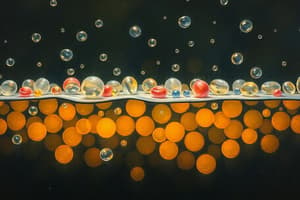Podcast
Questions and Answers
What is the primary role of the cell membrane in maintaining cellular stability?
What is the primary role of the cell membrane in maintaining cellular stability?
- Regulating the entry and exit of molecules. (correct)
- Synthesizing proteins for cell function.
- Generating energy through cellular respiration.
- Storing genetic information for cell division.
Which characteristic of phospholipids allows them to form a bilayer in cell membranes?
Which characteristic of phospholipids allows them to form a bilayer in cell membranes?
- Exhibiting a strong attraction to non-polar substances.
- Containing three fatty acid tails.
- Possessing both hydrophilic and hydrophobic regions. (correct)
- Having a completely hydrophobic structure.
In the context of cell membranes, what is the primary difference between diffusion and osmosis?
In the context of cell membranes, what is the primary difference between diffusion and osmosis?
- Diffusion involves the movement of solute molecules, while osmosis involves the movement of solvent molecules. (correct)
- Osmosis involves the movement of solute molecules, while diffusion involves the movement of water.
- Osmosis only occurs in active transport, while diffusion occurs in passive transport.
- Diffusion requires energy input, while osmosis does not.
How do hypertonic solutions affect cells?
How do hypertonic solutions affect cells?
What is the main function of transport proteins in facilitated diffusion?
What is the main function of transport proteins in facilitated diffusion?
Which of the following is a key characteristic of active transport?
Which of the following is a key characteristic of active transport?
What role do K+ and Na+ ions play in the sodium-potassium pump?
What role do K+ and Na+ ions play in the sodium-potassium pump?
How do cells transport large particles across the cell membrane?
How do cells transport large particles across the cell membrane?
If a cell is placed in an isotonic solution, what will happen to the movement of water?
If a cell is placed in an isotonic solution, what will happen to the movement of water?
What is the primary function of the cell membrane?
What is the primary function of the cell membrane?
Which of the following is the correct composition of a phospholipid?
Which of the following is the correct composition of a phospholipid?
Why do hydrophobic tails of phospholipids orient themselves toward the center of the cell membrane?
Why do hydrophobic tails of phospholipids orient themselves toward the center of the cell membrane?
What type of molecules can easily diffuse across the cell membrane?
What type of molecules can easily diffuse across the cell membrane?
How does the concentration gradient affect the rate of diffusion?
How does the concentration gradient affect the rate of diffusion?
Which of the following is a characteristic of facilitated diffusion?
Which of the following is a characteristic of facilitated diffusion?
In the sodium-potassium pump, what is the ratio of Na+ ions pumped out of the cell to K+ ions pumped into the cell?
In the sodium-potassium pump, what is the ratio of Na+ ions pumped out of the cell to K+ ions pumped into the cell?
What is the function of glycoproteins in the cell membrane?
What is the function of glycoproteins in the cell membrane?
During endocytosis, what happens to the cell membrane?
During endocytosis, what happens to the cell membrane?
What is the primary difference between passive and active transport?
What is the primary difference between passive and active transport?
How does co-transport utilize the artificial concentration gradients created by active transport?
How does co-transport utilize the artificial concentration gradients created by active transport?
Flashcards
Hydrophilic molecule
Hydrophilic molecule
A molecule attracted to water, usually polar or ionic.
Hydrophobic molecule
Hydrophobic molecule
A molecule repellent to water, typically non-polar, like oil.
Phospholipid
Phospholipid
A lipid consisting of a glycerol, two fatty acids, a phosphate group, and a nitrogen group, forming a bilayer in cell membranes.
Homeostasis
Homeostasis
Signup and view all the flashcards
Diffusion
Diffusion
Signup and view all the flashcards
Osmosis
Osmosis
Signup and view all the flashcards
Isotonic
Isotonic
Signup and view all the flashcards
Hypotonic
Hypotonic
Signup and view all the flashcards
Hypertonic
Hypertonic
Signup and view all the flashcards
Facilitated Diffusion
Facilitated Diffusion
Signup and view all the flashcards
Active Transport
Active Transport
Signup and view all the flashcards
Endocytosis
Endocytosis
Signup and view all the flashcards
Exocytosis
Exocytosis
Signup and view all the flashcards
Study Notes
Cell Membrane Roles
- Transports essential substances into the cell
- Removes waste and harmful substances
- Prevents harmful substances from entering or leaving the cell
Hydrophilic vs. Hydrophobic
- Hydrophilic molecules are attracted to water and are usually polar or ionic
- Hydrophobic molecules repel water and are usually non-polar, like oil
Phospholipids
- Composed of a glycerol, two fatty acids, a phosphate group, and a nitrogen group
- The phosphate head is hydrophilic and attracts water inside and outside the cell
- The fatty acid tails are hydrophobic, repelling water and orienting toward the membrane's center
- Arranged in a bilayer, forming the cell membrane
Cell Membrane Components
- Contains proteins (intramembranous, peripheral, glycoproteins) and lipids
- Lipids include phospholipids, cholesterol, and glycolipids
Transport and Homeostasis
- Maintaining stable internal conditions in a cell is called homeostasis
- The cell membrane regulates molecule entry and exit
Types of Transport
- Passive transport: No energy required, includes diffusion, osmosis and aided diffusion
- Active transport: Requires energy, such as the sodium/potassium pump
Passive Transport
- Transports small molecules via diffusion and osmosis
- Diffusion involves solute movement from high to low concentration areas
- Osmosis involves solvent (water) diffusion through a semi-permeable membrane
Diffusion Details
- Used by small, neutral molecules like oxygen and carbon dioxide
- The concentration gradient is lower inside the cell than outside
- Movement is random, but net movement follows the concentration gradient
- Diffusion rate depends on the gradient; a greater difference increases the rate
Osmosis Explained
- It is the diffusion of a solvent (water) across a semi-permeable membrane
- Water moves from areas of low solute concentration to areas of high solute concentration
Tonicity
- Isotonic: Equal water concentration inside and outside the cell, resulting in equal water movement
- Hypotonic: Lower solute concentration outside the cell, causing inward water movement
- Hypertonic: Higher solute concentration outside the cell, causing outward water movement
Facilitated Diffusion
- Applies for molecules too large for regular diffusion, such as glucose
- Utilizes transport proteins and protein channels with 3D structures for specificity, allowing only one substance to pass
- Substances move along the concentration gradient from high to low concentration and does not require energy
- Protein channels also facilitate the passage of charged substances that transport proteins cannot
Active Transport
- Transports molecules against the concentration gradient
- Seen in kidneys, intestines, plant roots, and fish gills
- Requires energy in the form of ATP
- Sodium/Potassium Pump: Exchanges 2 K+ ions into the cell for 3 Na+ ions out, requiring energy
- Co-transport: Uses artificial concentration gradients created by active transport to move molecules like glucose
Transport of Large Particles
- Accomplished using vacuoles that fuse with the cell membrane to release their contents
- Endocytosis: The cell membrane folds inward to form a vesicle, bringing large substances into the cell
- Exocytosis: The reverse of endocytosis
Studying That Suits You
Use AI to generate personalized quizzes and flashcards to suit your learning preferences.




